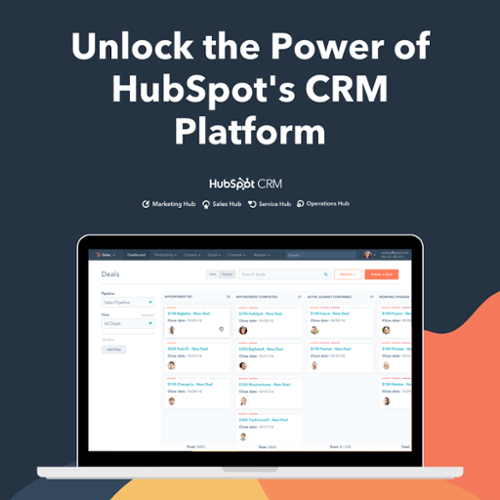Do project delays and communication gaps create challenges in your workflows? Why not choose a platform that effectively handles project management, facilitates team collaboration, and automates your tasks for a seamless experience?
HubSpot and Asana are two popular platforms that can help you to streamline your tasks. Asana, a dedicated project management software, excels in organizing tasks, facilitating document sharing, and managing project timelines with precision.
While, HubSpot goes beyond project management, offering a versatile CRM software that includes CMS, lead management, marketing automation, customer service, and more.  This quick overview just highlights the basics. Join us as we compare HubSpot vs Asana and explore all the features these platforms offer. Let's uncover the details and find the best solution for your organization.
This quick overview just highlights the basics. Join us as we compare HubSpot vs Asana and explore all the features these platforms offer. Let's uncover the details and find the best solution for your organization.
HubSpot CRM vs Asana: 7 Key Differences
1. HubSpot vs Asana: Project Management
Effective project management is crucial for ensuring projects are delivered efficiently and meet their objectives. Now let's compare HubSpot and Asana and evaluate their project management capabilities.
HubSpot
HubSpot offers a robust set of features to support project management, streamlining tasks and collaboration within teams. It allows you to create and assign tasks to team members. You can set due dates, add descriptions, and keep everyone on the same page about what needs to be done.
HubSpot also enables seamless collaboration among team members. You can share files, comments, and updates within the platform, fostering efficient communication. The CRM platform provides visual project timelines that give you a clear overview of project progress. This helps in tracking milestones and ensuring that the deadlines are met.
The CRM platform provides visual project timelines that give you a clear overview of project progress. This helps in tracking milestones and ensuring that the deadlines are met.
With HubSpot's Gantt charts visually represent project timelines, dependencies, and task relationships. This feature provides a comprehensive view of project schedules, aiding in effective planning.
HubSpot also provides a user-friendly and comprehensive project management solution that covers task management, collaboration, automation, and reporting. The platform's flexibility and integration capabilities make it a powerful tool for teams looking to streamline their project workflows.
Asana
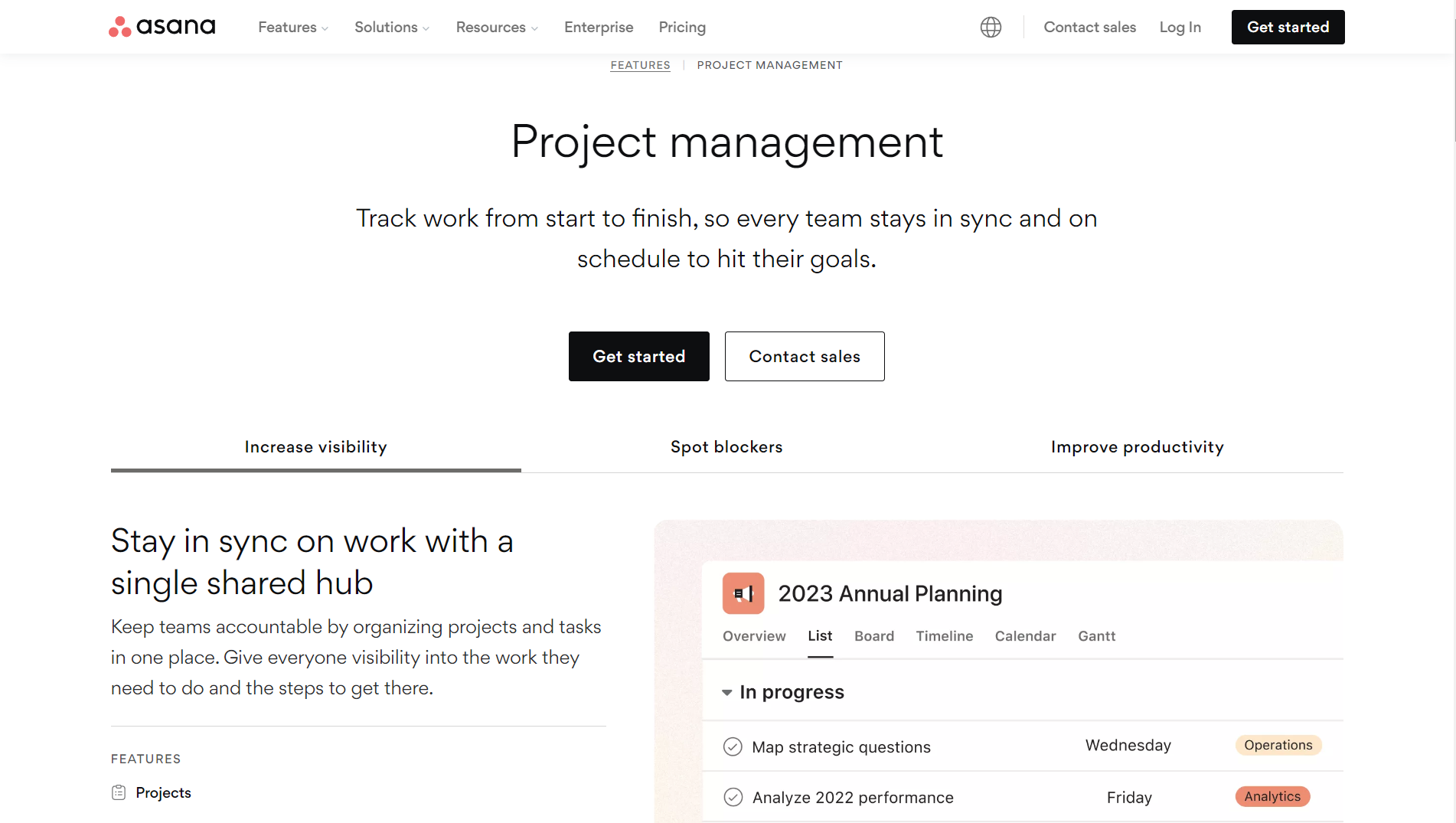
Moreover, it is flexible and can be adapted to different project management styles. You can customize projects, tasks, and workflows to suit your team's specific needs. This adaptability makes it suitable for a wide range of projects and industries.
Verdict
Asana takes the lead in project management with its intuitive user interface, task organization, and efficient project timeline management, making it a choice for streamlined project workflows.
2. HubSpot vs Asana: Integration Ecosystem
The ability of a platform to integrate with various tools and applications can impact workflow efficiency and overall productivity. Let's evaluate the integration capabilities of HubSpot and Asana to help you make an informed decision for your business needs.
HubSpot
HubSpot is designed to work seamlessly with a variety of third-party tools and services. This means you can connect it to other software your team already uses, like Google Workspace, Microsoft Office, or project management tools, creating a unified and interconnected work environment.
HubSpot's integration with Customer Relationship Management (CRM) tools like Salesforce is a key strength. It allows you to centralize customer information, track interactions, and manage your sales pipeline more efficiently.
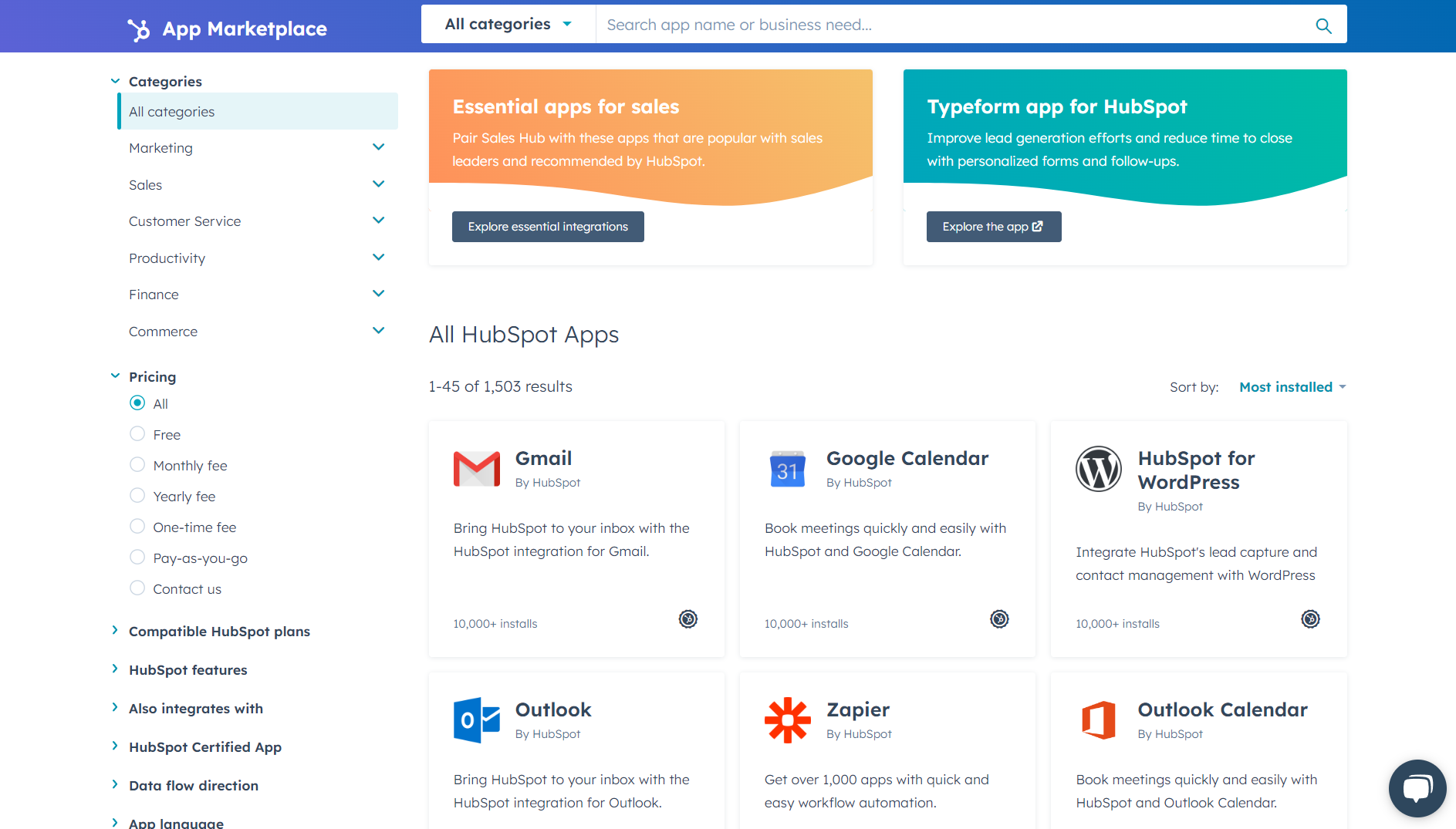 For businesses involved in e-commerce, HubSpot integrates with various e-commerce platforms. This allows you to track customer interactions, manage sales, and align your marketing efforts with your online store seamlessly.
For businesses involved in e-commerce, HubSpot integrates with various e-commerce platforms. This allows you to track customer interactions, manage sales, and align your marketing efforts with your online store seamlessly.
HubSpot provides tools and APIs (Application Programming Interfaces) that developers can use to create custom integrations tailored to your specific business needs. This flexibility allows you to extend HubSpot's functionality to suit your unique requirements.
Explore the HubSpot App Marketplace, where you can find a wide range of pre-built integrations. This makes it easy to discover and implement new tools that seamlessly connect with HubSpot.
 Asana
Asana
Asana integrates with various popular tools like Google Drive, Dropbox, and Slack. This means that you can work on your tasks and projects without constantly switching between different apps.
Asana and Slack integration allows you to receive updates and notifications from Asana directly in your Slack channels. This way, your team can stay informed about project progress without having to check Asana separately.
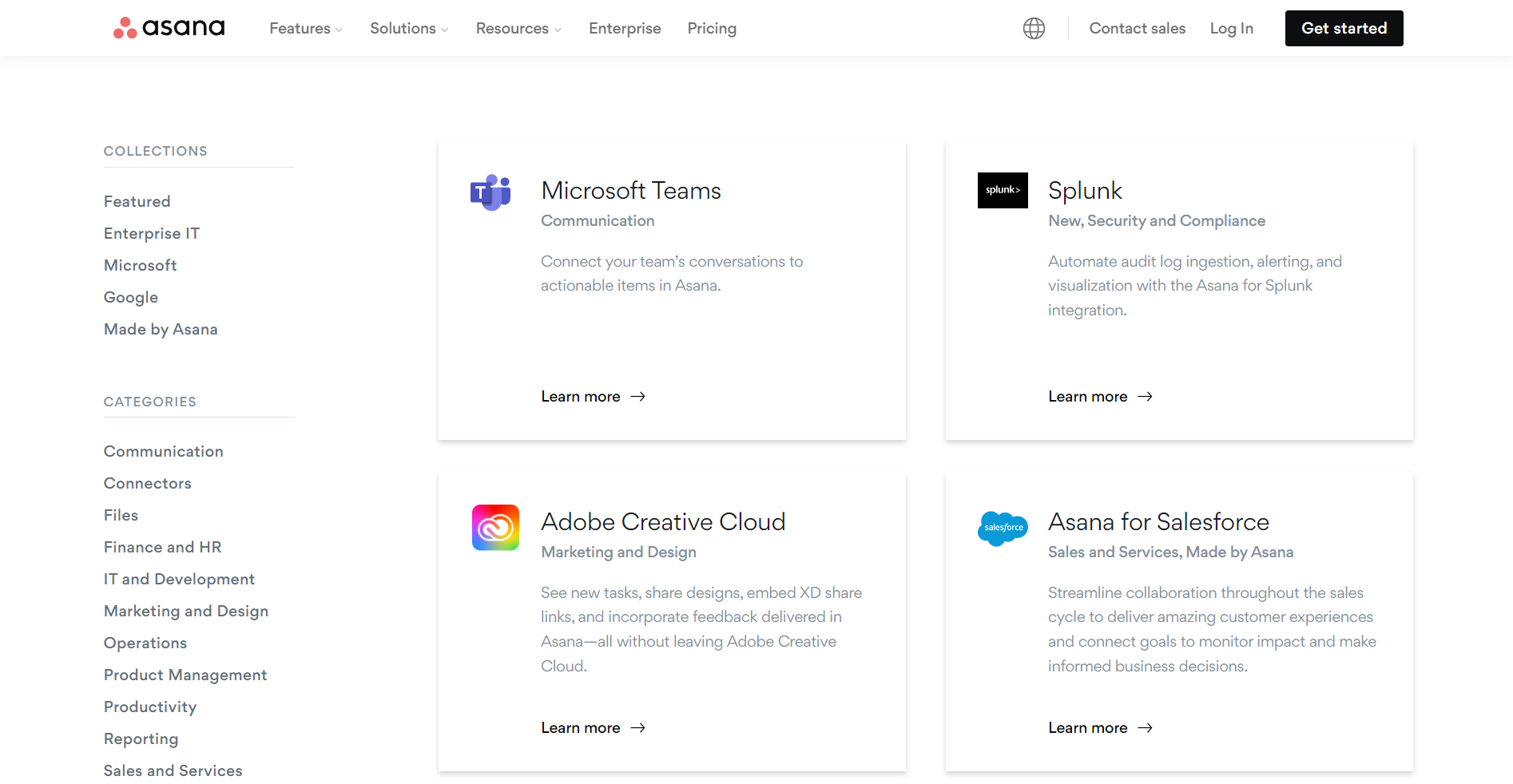 Your Asana tasks and deadlines can be synced with your Google Calendar. This integration ensures that your project timelines are reflected in your calendar, helping you manage your time effectively and never miss an important deadline.
Your Asana tasks and deadlines can be synced with your Google Calendar. This integration ensures that your project timelines are reflected in your calendar, helping you manage your time effectively and never miss an important deadline.
It also integrates with time-tracking tools like Harvest or Toggl. This is useful for tracking the time spent on each task, which is crucial for project management and billing clients accurately.
Overall, Asana integrations streamline workflows, reduce manual tasks, and ensure that information is seamlessly shared across different applications, enhancing collaboration and productivity.
Verdict
HubSpot takes the lead in integration features by offering various solutions that seamlessly connect CMS, lead management, marketing automation, and customer service.
3. HubSpot vs Asana: Reporting and Analytics
In terms of Reporting and Analytics, HubSpot and Asana both offer unique features to enhance project visibility and performance. Let's compare their respective reporting tools helpful for your business analysis.
HubSpot
HubSpot's Reporting & Analytics provides in-depth insights into various aspects of their operations. Dive into detailed data about your website's performance.
HubSpot's analytics help you understand which pages are popular, how visitors navigate your site, and where potential improvements can be made for a better user experience.
HubSpot's reporting features provide real-time data, allowing you to stay updated on the latest developments. This is crucial for making agile decisions and adapting your strategies based on current trends.
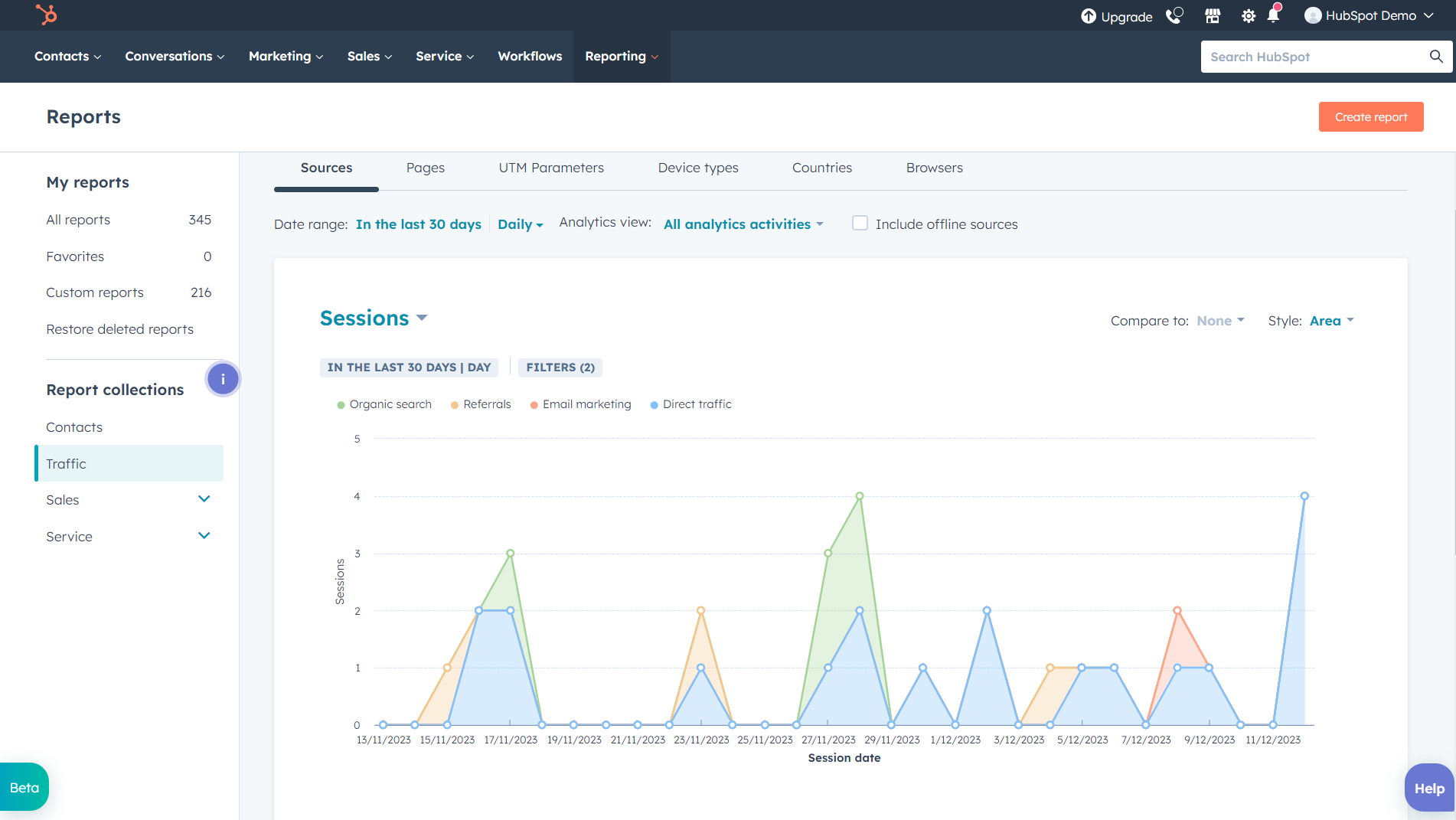 The platform uses visual elements like charts and graphs to represent data, making it easier to comprehend complex information. This visual approach helps in quickly identifying trends and patterns.
The platform uses visual elements like charts and graphs to represent data, making it easier to comprehend complex information. This visual approach helps in quickly identifying trends and patterns.
HubSpot allows you to export your reports in various formats, making it convenient to share insights with team members, and stakeholders, or for further analysis outside the platform for your business.
Set specific goals for your marketing and sales activities, and HubSpot will track your progress toward achieving them. This goal-oriented approach ensures that your efforts align with your business objectives.
Asana
Whether you're tracking progress, managing workloads, analyzing time spent, or evaluating project milestones, Asana's reporting tools and timeline view help you make informed decisions and keep your projects on track.
If your team tracks time spent on tasks, Asana's reports can provide insights into time allocations. This is useful for understanding where time is being invested and optimizing productivity.
You can also see how your projects and tasks have evolved, helping you identify trends and patterns for future planning.
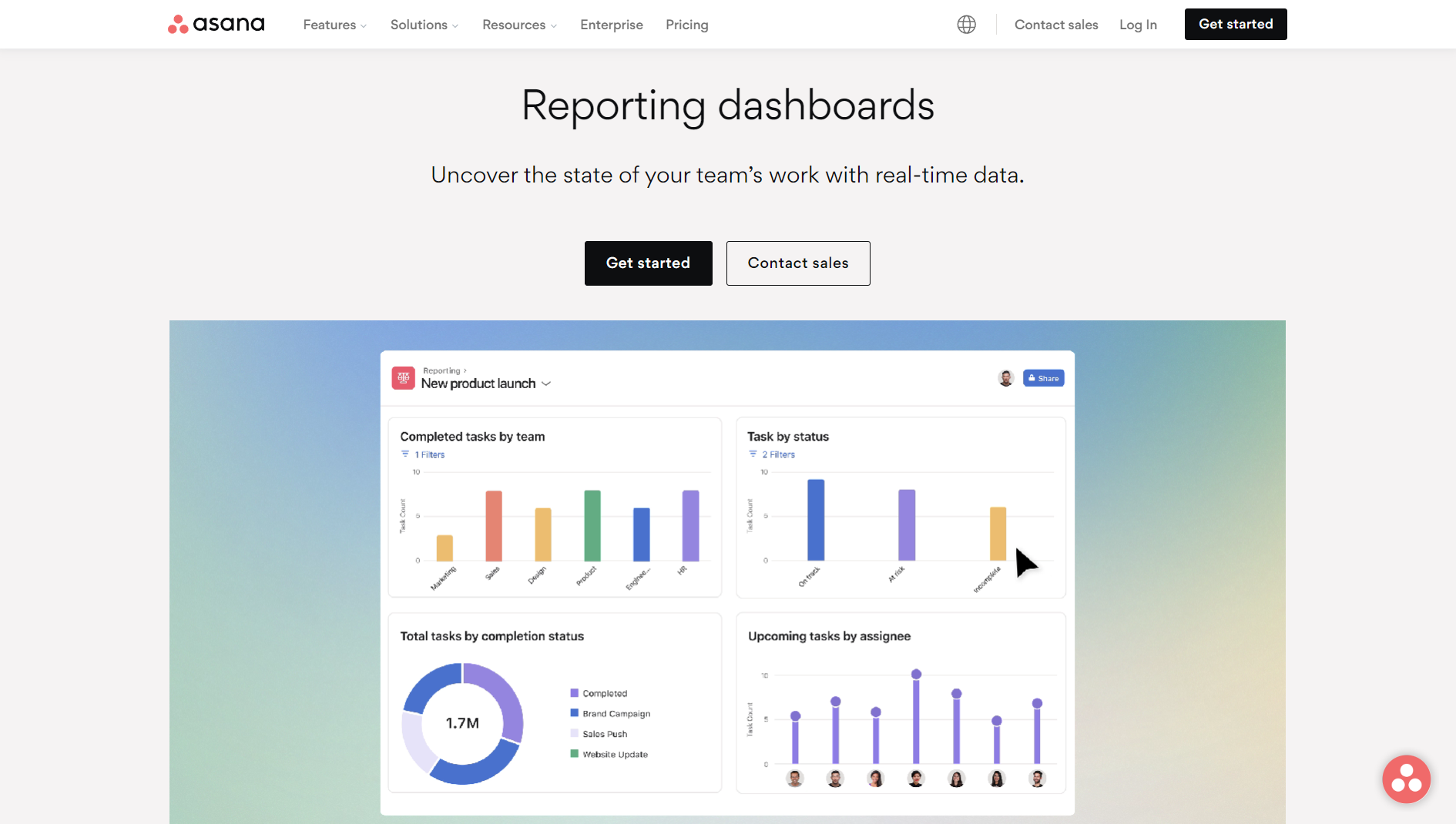 It further allows you to track tasks based on their due dates ensuring that your team stays on schedule. The reports can highlight project milestones and their status giving you an overview of significant achievements.
It further allows you to track tasks based on their due dates ensuring that your team stays on schedule. The reports can highlight project milestones and their status giving you an overview of significant achievements.
It also offers workload reports, giving you a clear picture of how tasks are distributed among team members. This helps in balancing workloads and making sure no one is overloaded or underutilized.
Asana lets you export data from reports, which is useful for further analysis or sharing information with project managers and stakeholders. This flexibility enhances your ability to use the data outside of the Asana platform.
Verdict
HubSpot stands out in reporting and analysis features. With analytics tools, customizable reports, and detailed insights, HubSpot empowers businesses to make data-driven decisions.
4. HubSpot vs Asana: Automation and Workflow
Marketing automation software helps in enhancing efficiency, productivity, and performance. It facilitates ease of use and reduces the need for manual, repetitive tasks.
This saves time for employees, allowing them to focus more on strategic tasks. Let's compare Asana and HubSpot for their automation capabilities.
HubSpot
HubSpot allows you to create workflows, which are sequences of automated actions triggered by specific conditions. This helps in automating workflows that would otherwise require manual intervention.
It allows you to automate your email communications based on predefined triggers. For example, you can set up automated welcome emails for new subscribers or follow-up emails for leads who have shown interest in a particular product.
 HubSpot also allows you to streamline your task management by automating certain actions. For instance, you can set up a workflow to automatically create tasks for team members when specific milestones are reached.
HubSpot also allows you to streamline your task management by automating certain actions. For instance, you can set up a workflow to automatically create tasks for team members when specific milestones are reached.
Moreover, you can automate parts of your sales process, such as assigning leads to sales reps, updating deal stages, and sending follow-up communications. It also lets you assign scores to leads based on their interactions and helps in identifying high-potential leads.
Asana
Asana allows you to automate repetitive tasks. For example, you can set up rules that automatically assign tasks to specific team members when they are created or move tasks to different project sections based on their status.
It integrates with form-building tools like Wufoo or JotForm. When someone fills out a form, it automatically creates a task based on the submitted information. This eliminates the need for manual data entry and speeds up the process of turning information into actionable tasks.
 Asana also allows you to create project templates with predefined tasks and workflows. When you start a new project, you can use these templates, saving time and ensuring project consistency.
Asana also allows you to create project templates with predefined tasks and workflows. When you start a new project, you can use these templates, saving time and ensuring project consistency.
Its custom rules feature lets you create rules that suit your team's specific needs. For instance, you can automate the assignment of tasks based on keywords or tags, making it easy to organize and distribute work efficiently.
What's more! With Asana, you can also set up automatic reminders for task due dates. As the due date approaches, Asana will notify the assigned team members, reducing the chances of missing deadlines and ensuring that everyone stays on track.
Verdict
HubSpot is considered top-notch marketing software with automation capabilities. It allows you to automate repetitive tasks, streamline workflows, and enhance overall efficiency.
5. HubSpot vs Asana: Privacy & Data Security
In today's world, where data privacy and security are crucial, businesses must carefully choose the platform for managing their projects and customer relationships.HubSpot uses encryption to safeguard your data. This means that when information is transmitted between your computer and HubSpot's servers, it's encoded, making it difficult for unauthorized parties to access or understand the data.
It also hosts its platform on secure servers. These servers are maintained in controlled environments with strict access controls, ensuring that only authorized personnel can physically interact with them.
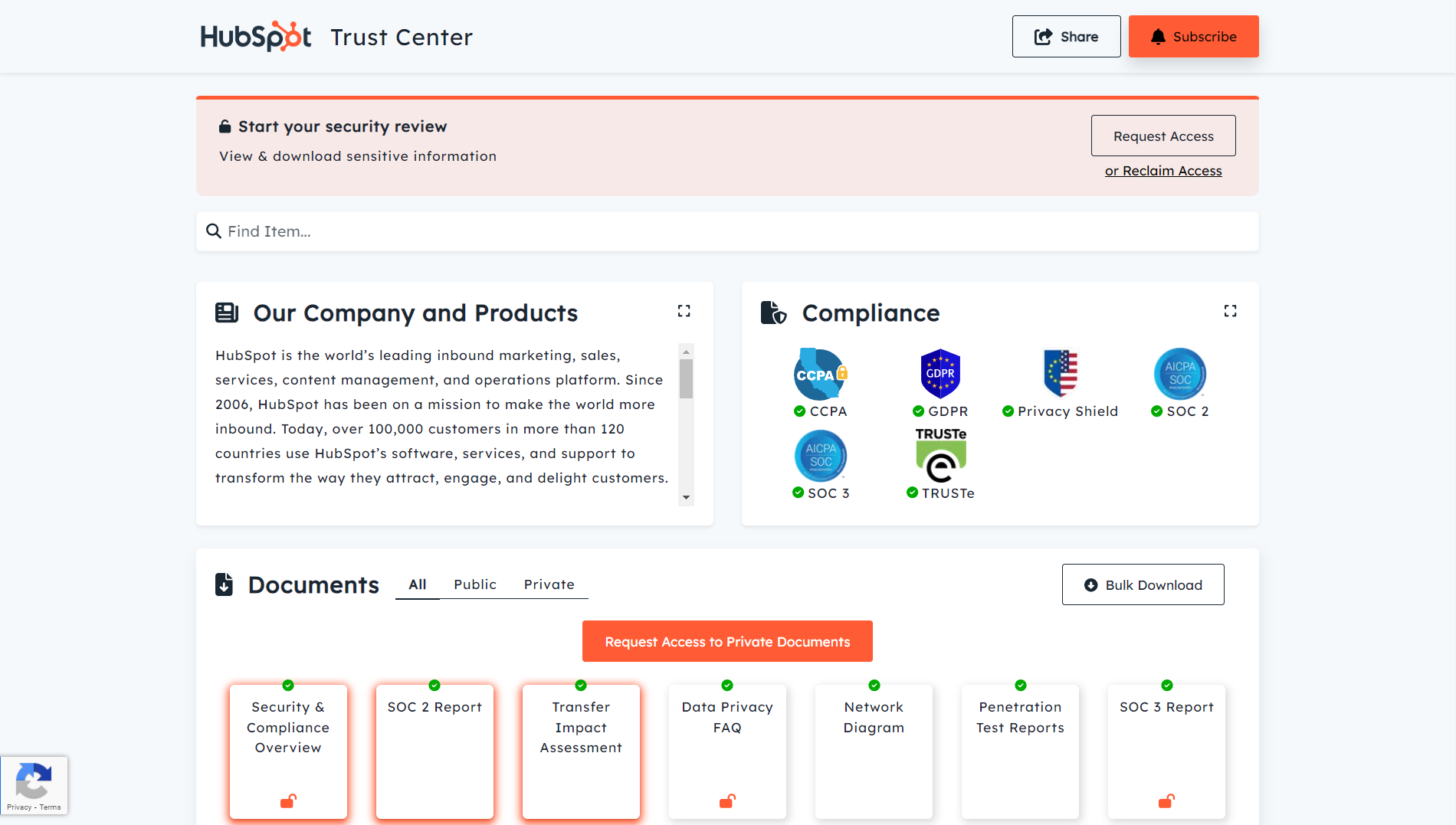
Further, HubSpot allows you to control user permissions. You can assign different roles and permissions to team members, ensuring that only those who need specific information or features have access to them.
For enhanced data security and to prevent unauthorized access, HubSpot uses robust user authentication methods. This involves secure login processes, including the use of strong passwords and sometimes additional security measures like two-factor authentication.
HubSpot also adheres to data protection regulations and standards. This includes compliance with regulations such as GDPR (General Data Protection Regulation) and other regional data protection laws, demonstrating a commitment to the highest standards of data privacy.
Asana
Your data in Asana is kept in super-secure space called data centers. These centers have guards (virtual and real ones), like firewalls and security systems, to make sure no one gets in who shouldn't.
To get into your Asana account, you need a strong password. They also offer an extra layer of protection, like a secret code sent to your phone, making sure only you can access your account.
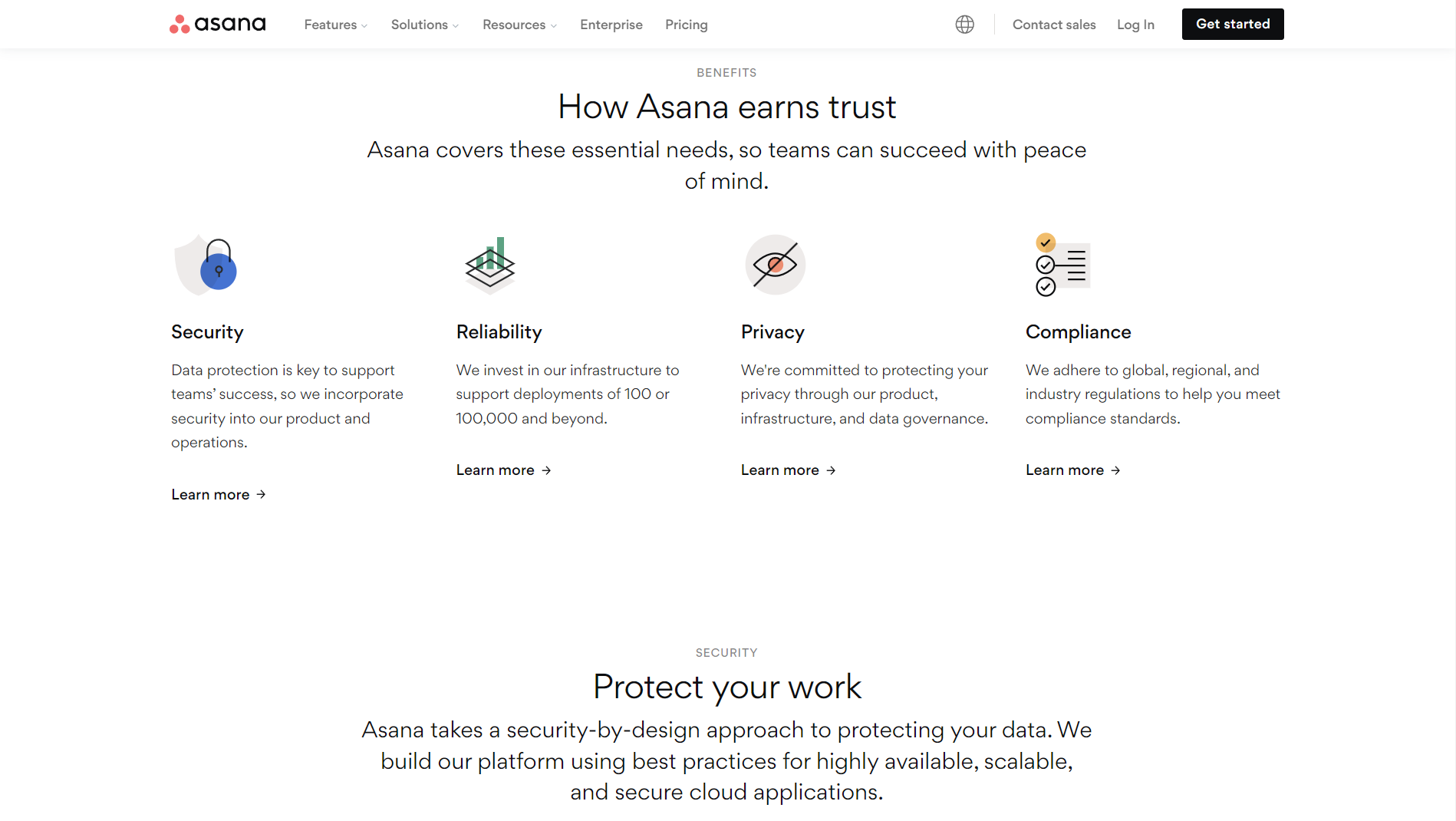 Asana also follows important rules about data protection. These rules are like a set of promises that companies make to keep your data safe. Asana sticks to these promises and even goes beyond to make sure your information is in good hands.
Asana also follows important rules about data protection. These rules are like a set of promises that companies make to keep your data safe. Asana sticks to these promises and even goes beyond to make sure your information is in good hands.
Additionally, it regularly checks and tests its security to make sure everything is super safe. They're like doctors for the safety of your data, making sure there are no hidden issues.
Asana is open about how they use your data. You can read their privacy policy to understand exactly what they do with your information. This transparency helps you trust that your data is being handled responsibly.
Verdict
Both HubSpot and Asana prioritize data security, employing robust measures such as encryption, secure cloud infrastructure, and stringent access controls.
6. HubSpot vs Asana: Customer Support
Effective customer support and training resources are essential for ensuring a smooth adoption of the chosen platform.
HubSpot
HubSpot is committed to providing excellent customer support and comprehensive training features to help users make the most of their platform.
It offers a Knowledge Base, which is a collection of articles, guides, and tutorials. This resource is designed to help users find answers to common questions and learn how to use different features of the platform.
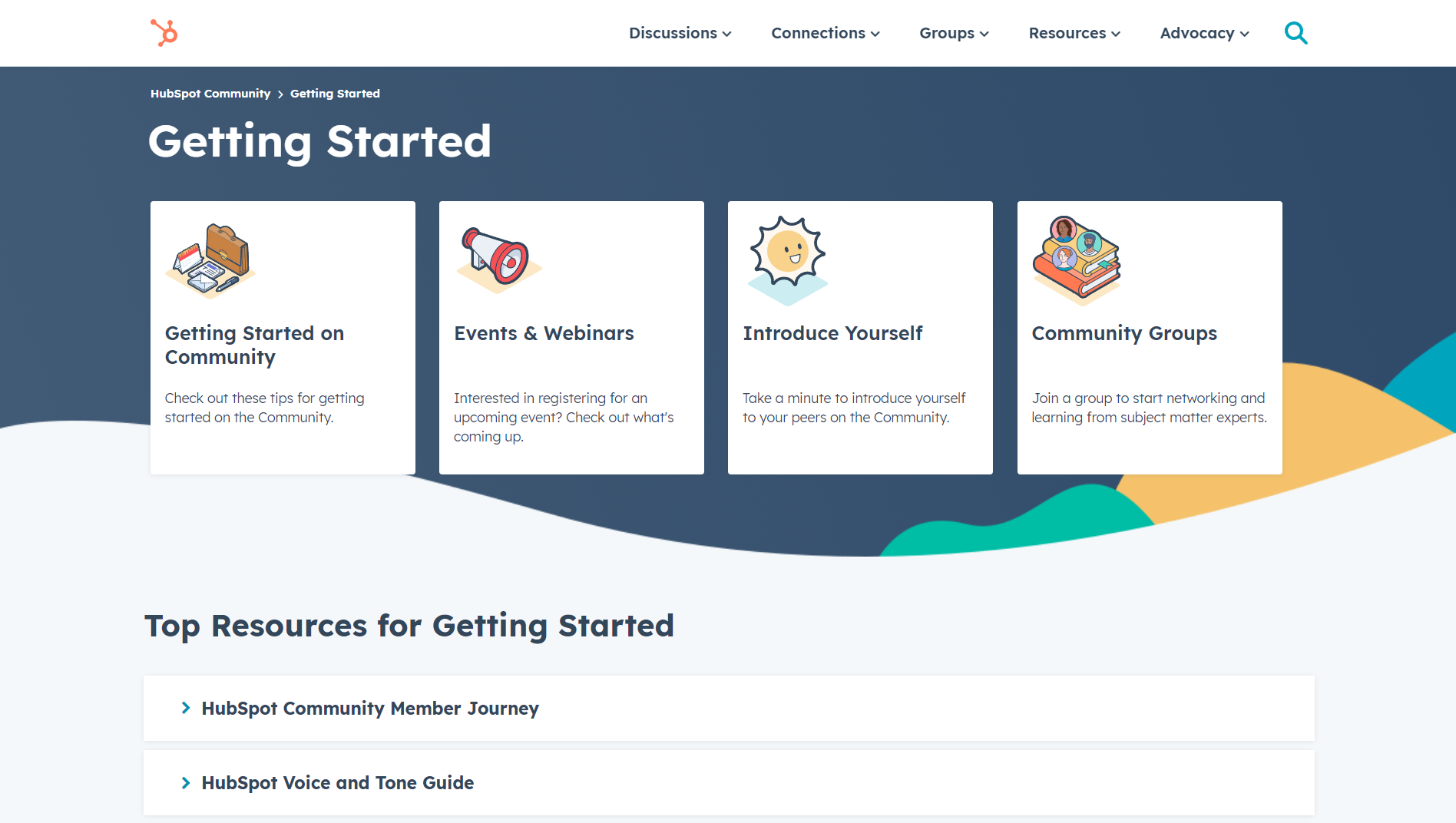 It also provides video tutorials that visually guide users through various aspects of the platform. These videos are a helpful resource for those who prefer a more interactive and visual learning experience.
It also provides video tutorials that visually guide users through various aspects of the platform. These videos are a helpful resource for those who prefer a more interactive and visual learning experience.
With HubSpot online training courses and certification programs, you can deepen your expertise in specific areas such as inbound marketing, content marketing, sales, social media and more.
Moreover, HubSpot conducts live webinars which cover various topics, providing users with the opportunity to ask questions and interact with the HubSpot team.
With 24/7 email support, it addresses user inquiries and issues. Users can reach out to the support team via email to get assistance with any challenges they may be facing. Depending on the plan, HubSpot may offer phone support, allowing users to speak directly with support representatives for more immediate assistance.
HubSpot provides a variety of resources to ensure users can effectively leverage the platform for their business needs.
Asana
Asana is not just a tool; it's backed by a support and training ecosystem that's designed to make your experience smooth. Whether you prefer guides, videos, live sessions, or community discussions, Asana provides a variety of resources to ensure you're well-supported on your project management journey.
 It provides guides to help you understand how to use different features of the platform. It's like having step-by-step instructions to make your Asana journey smoother. And if you're more of a visual learner, Asana offers video tutorials.
It provides guides to help you understand how to use different features of the platform. It's like having step-by-step instructions to make your Asana journey smoother. And if you're more of a visual learner, Asana offers video tutorials.
Asana also hosts webinars so that you can interact with experts and ask questions in real time.
Additionally, it has a community forum where users share tips and tricks. You can learn from others' experiences and even share your insights. It also features a Help Center where you can search for answers to your questions.
Verdict
HubSpot stands out as the superior choice for customer support. Its commitment to customer service with large documentation, responsive support, and a great user community, makes it a go-to platform for reliable assistance.
7. HubSpot vs Asana: Pricing
HubSpot
HubSpot offers a range of pricing plans, including free CRM and project management features. The paid plans, such as Starter, Professional, and Enterprise, offer more advanced capabilities and scalability.
 HubSpot's pricing model is transparent and can be a cost-effective solution for businesses of various sizes.
HubSpot's pricing model is transparent and can be a cost-effective solution for businesses of various sizes.
Asana
Asana offers pricing plans based on the number of users and additional features required. While it provides a free plan with basic task and project management features, the more advanced features are available in the Premium and Business plans.
 Asana's pricing can be competitive for smaller teams but may become costly as your organization grows and requires additional features.
Asana's pricing can be competitive for smaller teams but may become costly as your organization grows and requires additional features.
Verdict
What suits your workflow preferences: HubSpot or Asana?
Our comparison of Asana vs. HubSpot reveals the strengths and functionalities of HubSpot & Asana catering to different business needs.
Choose HubSpot if you prioritize a unified approach to customer relationship management and project management. You can seamlessly integrate project tasks with customer data and marketing efforts.
If your business goals revolve around managing tasks, then you may opt for the Asana project management platform.
As you've followed our comparison, which features of HubSpot and Asana do you consider crucial for your business? Comment and share your thoughts.
If you need any assistance with CRM or project management, feel free to contact us!
Frequently Asked Questions
Is Asana like HubSpot?
Asana is good for managing projects and collaborating with teams, helping you organize tasks and work efficiently. On the other hand, HubSpot specializes in marketing automation and sales management, assisting businesses in generating leads, nurturing customer relationships, and tracking sales processes. While both are valuable for businesses, Asana's strength lies in project management and teamwork, whereas HubSpot excels in marketing and sales functions. Choose the one that aligns with your specific needs and goals.
Is Asana good for CRM?
Asana, primarily a project management tool, can be adapted for basic CRM use. It offers a straightforward sales process but has constraints in advanced features like reporting and automation, making it less suitable for complex CRM needs. For small businesses starting out, Asana could serve as a viable, cost-effective CRM option, provided its limitations align with your requirements.
Why not to use Asana?
Asana has some drawbacks that may not make it the best choice for everyone. For new users, it can feel overwhelming, especially if they're not experienced with project management software. Unlike some alternatives, Asana doesn't allow you to assign a task to multiple team members. Additionally, its pricing can be higher compared to other project management tools, making it less cost-effective for some. Asana is a powerful tool, but it may not be the ideal choice for simpler projects or those who are just starting out. If these factors are important to you, you might want to consider alternatives.
What is HubSpot famous for?
HubSpot is renowned for being the top customer platform for growing businesses. It offers various tools for marketing, sales, customer service, content management, and operations. What sets HubSpot apart is its user-friendly approach; it's designed to cater to your business requirements without overwhelming complexity. HubSpot's integrated solutions provide a streamlined experience for businesses looking to scale effectively. Whether it's for marketing, sales, or customer service, HubSpot is a popular choice due to its comprehensive yet easy-to-use software suite.
